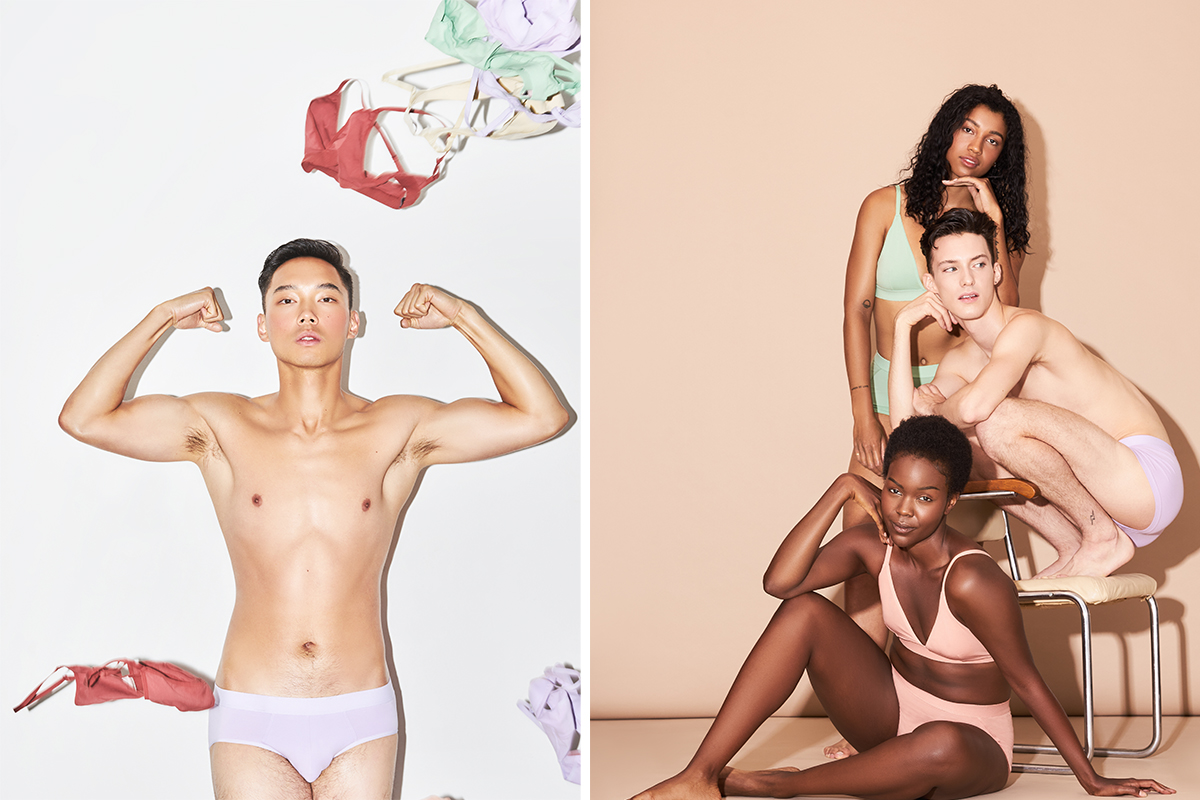Brands like Boy Smells and T Label are opening up lingerie beyond the gender binary.
It wasn’t long ago that the benchmark for intimate apparel existed within the bubblegum-pink confines of Victoria’s Secret, where inclusivity was not a priority, but reinforcing gender norms certainly was. Any shopper not within the VS size range was directed to their own little labeled box, dubbed either petite or 14-plus, further polarizing the intimates shopping experience. Victoria’s Secret set the tone for what they believed was the “perfect” physique, setting a standard for exclusivity not only within the VS brand, but the intimates market at large.
After a series of misfires on VS’s part, including unsavory comments made about transgender and plus-size models by the brand’s founder Ed Razek, news outlets and social media users alike quickly expressed their discontentment with the brand, even going so far as to boycott it. For every void left in the market, however, there are a number of creative minds ready to fill it. As the demand for more inclusive intimate-wear increased, a number of designers rose to the challenge, creating body-inclusive and non-gendered intimate wear across every price range and aesthetic.
One question that emerges in the conversation of gender-neutral clothing is what actually qualifies as “non-gendered.” Sure, anyone can go into a store and purchase what they like, regardless of the garment’s intended customer. However, as exemplified by the likes of Victoria’s Secret, there hasn’t always been an inclusive space around the buying experience. Everything, from the models brands employ to the wording they use to describe their products (see their botched “Perfect Body” campaign), plays a part in who they include in their brand, and this methodology can be used to make the brands as inclusive (or exclusive) as they desire.
“With underwear, perhaps more than any other category, binary ideas of gender and outdated societal expectations are used in marketing to consumers,” explains Matthew Herman, co-founder of Boy Smells. Known for its candles, the company recently relaunched a non-gendered underwear line, “Unmentionables.” “We hope to open the door and invite everyone to celebrate the full spectrum of their identity—no labels required.”
Brands like JBC Lingerie have also perfected the inclusive marketing strategy, including not only individuals of every size, shape, ethnicity, and gender identity on their pages, but also using encouraging and gender non-specific language in their content. As per their website, their lingerie “aims to aid you in loving yourself—to feel confident, happy and empowered in your body, sexuality, and who you are.” Their products feature delicate and traditional lingerie stylings—lace, mesh, and satin—in a contemporary and more inclusive manner.

These brands are proof that the intimacy and beauty of lingerie is not mutually exclusive to greater representation. U.K. brand T Label produces what they refer to as “romantic wear,” “inspired by traditional and old-fashioned stories of love and lust.” This romantic nostalgia has led to artful garments such as their signature bralettes composed of two shimmering satin gloves touching fingertips across the wearer’s chest.
This intimate inclusivity serves to change our own relationship with our bodies as well, and how we work with the body we’re born in. Feelings of gender dysphoria can commonly increase as individuals are placed in an intimate setting, driving home the importance of inclusive and comfortable language surrounding product descriptions and branding. Adopting a more casual aesthetic is the aforementioned “Unmentionables” line by Boy Smells, featuring bralettes, briefs and trunks with either a “Pouch Front” or “Flat Front” depending on what suits the buyer’s needs. “Wearing Unmentionables is about comfort and confidence—regardless of shape, size or gender identity,” explains Herman. “The way we label our underwear allows for the purchaser to decide how they relate to the product, we don’t dictate that.” The language employed on their platforms eliminates the mention of gender and body parts completely, simply making garments sans gendered-implications.
While the aforementioned brands may not have the prowess of giants like Victoria’s Secret, the adoption of inclusivity is not lost on some of the newer and more contemporary big lingerie brands. Savage X Fenty debuted their own size-inclusive line for men this past October, a rare moment where men were invited into the conversation about body inclusivity, as well. The show for the line featured everyone from drag queens to plus-sized and non-binary models, and created a space that not only de-emphasized the standard lingerie body type, but celebrated bodies of all stripes.
That progress is astounding compared to the intimate offerings of just a few years ago, yet the above brands barely scratch the surface of what the non-gendered intimate-apparel market has to offer, and what it could grow to become. From casual intimates to artful lingerie, there is now something for every shopper in the intimates space, so long as they choose to be there.
Image credit: Carl Ostberg/Boy Smells




